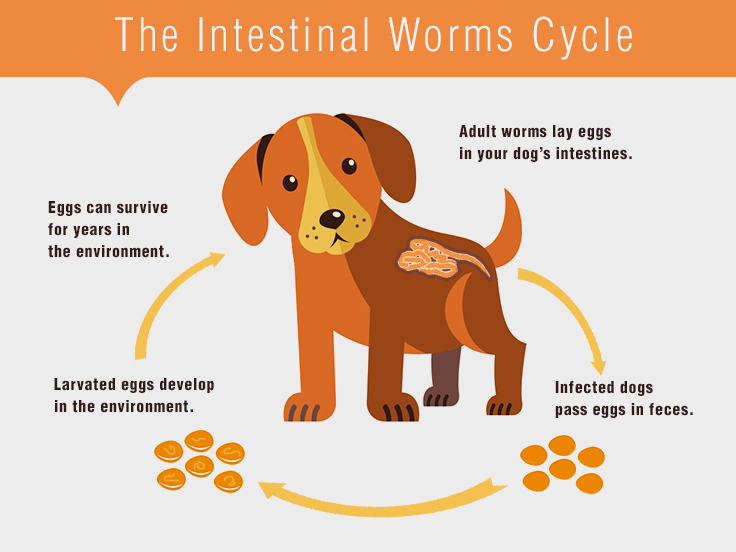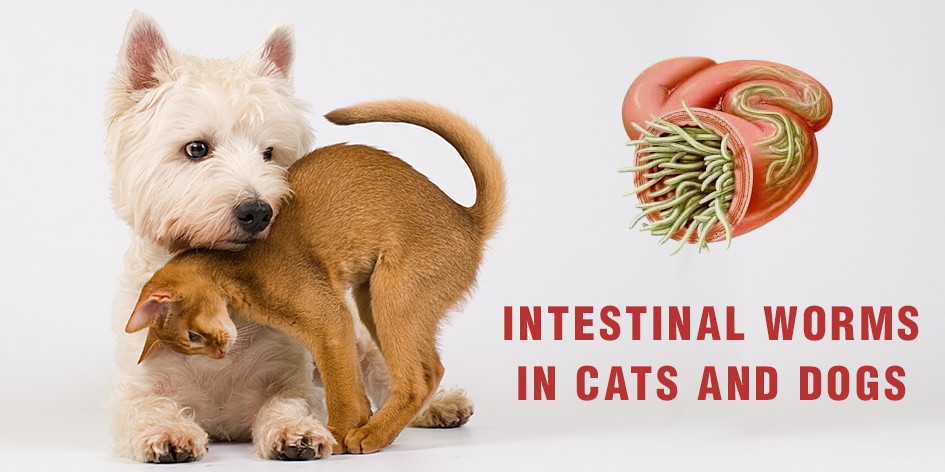One of the first things you will need to do when you acquire a new puppy or kitten is to get them onto a regular schedule for intestinal worming.
Worming is essential to keep your pets healthy, and will also avoid the risk of owners and their families being cross-infected by dog and cat worms.
The four main intestinal worms that affect cats and dogs are roundworm, whipworm, hookworm and tapeworm.
Pets that carry a significant burden of these worms can suffer from diarrhoea, vomiting, constipation, poor growth, and in rare cases, even death. Death can occur due to severe bowel impaction with worms or blood loss from blood-sucking hookworms.
Heartworms should be considered as a separate parasite, as they live in the heart, not the intestine, and require different prevention strategies. We will look at heartworm in a separate article, as they too can have a significant effect on pet health.
Read more about heartworm disease and prevention.
Signs that your pet could have worms
Pets carrying minor infections with intestinal worms may not show any signs of infection, but it is still critical that they receive regular deworming treatments. Young animal and geriatric pets are more likely to suffer from a significant worm burden. Pets in kennel situations are also more at risk of worm infections if the kennel hygiene is not perfect.
Outward signs of a worm burden can include a rough coat, weight loss or increased appetite; but other signs can include any of the following:
Possible signs of worm infection in your pet:
- Puppies and dogs may “scoot” their bottom along the ground
- Worms or small white tapeworm segments may be seen in your pet’s faeces or around their bottom; note- hookworms and whipworms are generally too small to be seen with the naked eye
- Pets may vomit, and may even vomit up worms
- Pets may show weakness, lethargy or dehydration
- Blood may be seen in the pet’s stool (poo)
- Pets can develop snaemia, in severe cases
- Puppies and kittens with large worm burdens can have a distended abdomen or ‘pot belly’ appearance
- Weight loss despite eating well
How can my pets get worms?
Dogs and cats usually become infected when they consume the larvae or eggs of worms when sniffing and licking the ground, licking themselves or other pets, or sniffing and licking faeces. Some pets may be born with worms from their mothers.
Animals can become infected with worms in several ways:
- Dogs and cats become infected from eating the larvae or eggs of worms.
- Dogs and cats may come in contact with the larvae or eggs of worms when sniffing and licking the ground, licking themselves or other pets, or sniffing and licking faeces. Female roundworms can lay hundreds of eggs a day, and these eggs have a tough shell that allows them to survive for months or years in the environment.
- Some worms can also be passed onto puppies from their mother before they are born or while they are suckling.
- Pets become infected with tapeworms when they eat fleas whilst grooming themselves or other pets; the fleas carry tapeworm eggs.
Diagnosing worm infections
Your vet can diagnose worm infections by testing a small stool (poo) sample for the presence of worm eggs. If you see any small white worm segments in your pet’s poo, let your vet know, as these are tapeworm segments.

Treating worm infections in your pet
All pet owners should follow the steps below to keep their pets and the people in the household free of dog and cat worms:
- Maintain a regular, effective worm control programme in all pets.
- Puppies and kittens should be treated with a high quality worm product from two weeks of age.
- Adult pets should be treated for roundworms, hookworms, whipworms and tapeworms at least every three months.
- Remove all faeces immediately after your pet defecates. Place all fecal waste in the bin.
- Do not allow your pet to sniff or eat faeces anywhere.
- Prevent tapeworms by using a flea treatment regularly, as fleas can carry tapeworm eggs.
- Wash and disinfect food and water bowls regularly.
- Ensure pet kennels and bedding are regularly cleaned and disinfected to kill worms and eggs. Only use a disinfectant that is safe for animals.
- Pregnant animals should be wormed regularly but always under the supervision of a vet, as some products are not safe for pregnant animals.
- Wash your hands thoroughly after handling pets and pet belongings.
- Never allow pets to consume offal from farm animals as this may contain cysts of the dangerous hydatid tapeworm.
REMEMBER: Worm eggs can survive on the ground for up to 5 years, so never assume your pet’s surroundings or dog common areas (dog parks etc) are completely free of worms or eggs.
Reducing the risk of humans becoming infected with worms from your pet
When humans are infected with dog and cat worms, the worm larvae do not pass to the human intestine, but migrate to other parts of the body. Hookworm larvae can penetrate the skin and can cause “cutaneous larval migrans”, which can result in a nasty reaction in the tissues with possible scarring. Roundworm (ascarid) eggs, if ingested, can cause a disease called “visceral larval migrans” where the larvae of the worm migrate through the person’s body and develop further in other parts of the body – called “visceral larval migrans”. One of the most common complications of this disease is severe eye damage.
To avoid serious disease in humans from infection with dog and cat worms, all people who handle pets and pet equipment should follow these guidelines:
- All people handling pets or any pet equipment must wash their hands after touching the pets/equipment and again before eating, drinking, cooking etc.
- Discourage family members from kissing pets and allowing pets to lick their face.
- Discourage pets from sleeping on family beds, especially near pillows.
- Train you pets to lie on blankets or towels whilst in the house; these can be shaken into the bin and washed regularly in very hot water to kill worms, eggs and larvae.
- Cover all kids’ play areas (such as sandpits) so pets cannot toilet in these areas.
When to worm your pets
To ensure your pets and family stay safe from worms, you should worm your pets with a quality allwormer treatment at the following intervals:
- Treat puppies and kittens every second week from the age of 2 weeks until they are 12 weeks old.
- Then treat every month until they are 6 months old.
- Treat adult cats and dogs every 3 months for life.
Dog Products
| Brand | Round worm |
Tape worm |
Whip worm |
Hook worm |
Heart worm |
Fleas |
| Canex |  |
 |
 |
 |
 |
 |
| Drontal Allwormer |  |
 |
 |
 |
 |
 |
| Milbemax(very small tablets) |  |
 |
 |
 |
 |
 |
| Endogard |  |
 |
 |
 |
 |
 |
| Cazitel |  |
 |
 |
 |
 |
 |
| Paragard |  |
 |
 |
 |
 |
 |
| Popantel |  |
 |
 |
 |
 |
 |
| Virbac Tapewormer tablets |  |
 |
 |
 |
 |
 |
| Interceptor Spectrum Tasty Chews |  |
 |
 |
 |
 |
 |
| Heartgard Plus |  |
 |
 |
 |
 |
 |
| Sentinel Spectrum Tasty Chews |  |
 |
 |
 |
 |
 |
| Panoramis(chewable tablet) |  |
 |
 |
 |
 |
 |
| Advocate(Spot On) |  |
 |
 |
 |
 |
 |
| Revolution(Spot On) + Canex |  |
 |
 |
 |
 |
 |
Dog Intestinal worm and Heartworm products – comparison chart
* This table gives simplified product -comparison information only. You should carefully read the individual product information to be sure the product is right for your pet.
Cat products
| Brand | Round worm |
Tape worm |
Whip worm |
Hook worm |
Heart worm |
Fleas |
| Felex Plus Allwormer paste |  |
 |
 |
 |
 |
 |
| Drontal Allwormer Tablets for cats |  |
 |
 |
 |
 |
 |
| Milbemax(very small tablets for cats) |  |
 |
 |
 |
 |
 |
| Popantel tablets |  |
 |
 |
 |
 |
 |
| Virbac Tapewormer tablets |  |
 |
 |
 |
 |
 |
| Profender Allwormer for cats Spot-on |  |
 |
 |
 |
 |
 |
| Advocate Spot on For cats |  |
 |
 |
 |
 |
 |
| Revolution Spot-on for cats |  |
 |
 |
 |
 |
 |
Cat Intestinal worm and Heartworm products – comparison chart
* This table gives simplified product -comparison information only. You should carefully read the individual product information to be sure the product is right for your pet.


